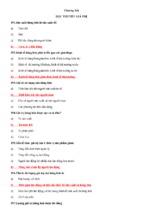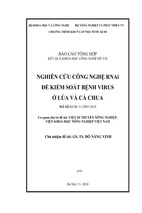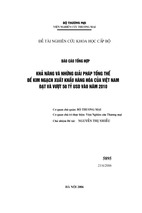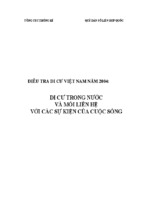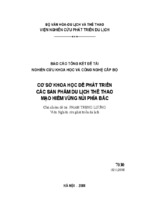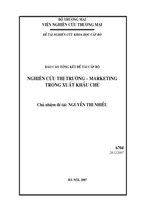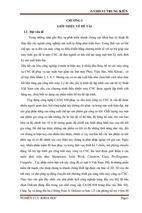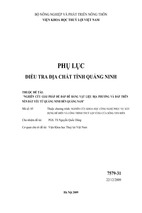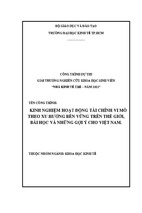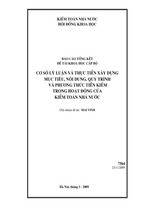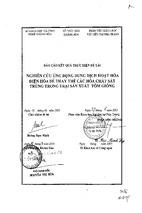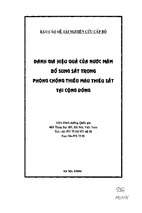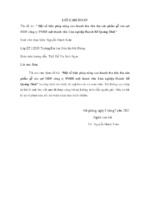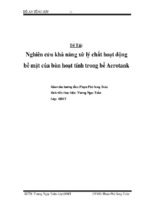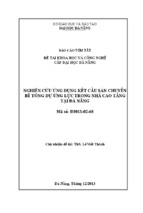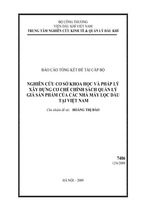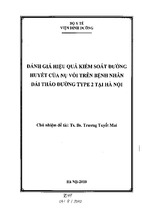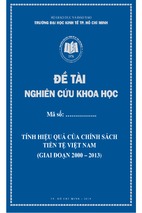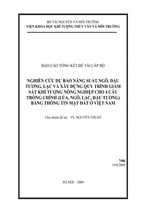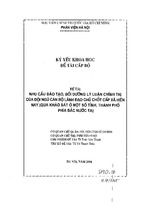THE RELATIONSHIP BETWEEN CORPORATE CULTURE AND THE USE
OF MANAGEMENT ACCOUNTING INNOVATIONS IN VIETNAMESE
COMPANIES: A STUDY OF TECHCOMBANK
BY
NGUYEN QUYNH THU
Graduation Project Submitted to the Department of Business Studies, HELP
University College, in Partial Fulfillment of the Requirements for the Degree of
Bachelor of Business (Accounting) Hons
October 2011
Declaration of Originality and Word Count
DECLARATION
I declare that this graduation project is based on my original work except for
quotations and citation which have been duly acknowledged. I also declare that it has
not been previously or concurrently submitted for any other courses/degrees at HELP
University College or other institutions.
Word Count: 11,602 words.
Nguyen Quynh Thu
Date
2
ACKNOWLEDGEMENT
The completion and result of this thesis paper is not only the achievement of efforts
from me but also the indispensable supports from a lot of helpful people. Firstly, I
would like to express my gratefulness to my dear teachers at the International
School, Vietnam National University where I spent nearly five years studying,
researching and growing. They have helped me and my friends enlarge our
knowledge as well as share with us lots of valuable experiences and lessons in life
which I will never forget. Especially, I would love to extend my heartfelt thanks to
my thesis’ supervisor, Mrs. Phan Thu Huong for her instruction and encouragement
during the time. She was not only the person who initiated and inspired me to the
topic of this paper, but also continuously supported and consulted me to find out
solutions and complete this paper. Without her and other teachers’ advices and helps,
I could not come to the destination and attain this result.
Additionally, it is my great honor to receive the enthusiastic supports from all
managers, chief accountant and other accounting staff who are involved in the survey
conducted in this thesis. Although the relationship between me and those people is
not close; however, I received one hundred percent replies over the questionnaire
papers sent through both emails and in hands. Based on their answers, the influence
of corporate culture on management accounting innovations in Techcombank has
been found out and contributed a big value to this research.
Finally, from the bottom of my heart, I would like to express my great thanks to all
of my family members and friends for their vital encouragement and cares during the
time conducting this thesis.
3
Once again, I’d love to send the profound feeling to the above-mentioned people,
hadn’t been for all their supports and suggestions, this paper cannot be properly
accomplished.
4
ABSTRACT
THE RELATIONSHIP BETWEEN CORPORATE CULTURE AND THE USE
OF MANAGEMENT ACCOUNTING INNOVATIONS IN VIETNAMESE
COMPANIES: A STUDY OF TECHCOMBANK
By
NGUYEN QUYNH THU
October 2011
Supervisor: Mrs. Phan Thu Huong
Corporate culture is no longer a new term for developing countries. It has developed
through the long history and nowadays it is expected to perform by any enterprises in
the world. However, the term is not familiar to Vietnamese enterprises until the
recent years when the economy is more open, corporate culture plays an important
role in development and initiation of Vietnamese enterprises.
In particular, this graduation project represents the results of research on the
relationship between corporate culture and the use of management accounting
innovations in Vietnamese companies, a case study of Techcombank. The objective
of the research is to access the understanding of Techcombank’s managers and
accountants about the influence of corporate culture on the initiations of managerial
accounting system.
In this thesis, the author reviews knowledge related to corporate culture and
management accounting innovations involving definitions, elements, roles and
theories of several international researches (Schein, Quinn and Rohrbaugh). The
5
author also analyzes the relationship between Techcombank’s corporate culture and
its management accounting innovations based on models of Schein, Quinn and
Rohrbaugh. Finally, from the success of Techcombank, the author will propose some
useful experience lessons for Vietnamese companies.
6
TABLE OF CONTENT
Declaration of Originality and Word Count ...................................................... 2
Acknowledgement ..................................................................................................3
Abstract ...................................................................................................................5
Table of contents ....................................................................................................7
List of Figures .......................................................................................................11
List of Abbreviations ...........................................................................................13
CHAPTER I – INTRODUCTION......................................................................14
1.1. Research background ...................................................................................14
1.2. Research objectives .......................................................................................15
1.3. Research significant ......................................................................................16
1.4. Research questions ........................................................................................16
1.5. Scope of research ...........................................................................................16
1.6. Structure of research ....................................................................................17
CHAPTER II – LITERATURE REVIEW ........................................................18
2.1. Overview of corporate culture .....................................................................18
2.1.1. Definition of culture .....................................................................................18
2.1.2. Definition of corporate culture .....................................................................19
2.1.3. The role of corporate culture in business .....................................................20
7
2.1.3.1. Fostering innovation and invention...............................................20
2.1.3.2. Creating corporate vision, shared values and beliefs ....................22
2.1.3.3. Creating the competitive advantage ..............................................22
2.2. Overview of the innovation of management accounting ...........................23
2.2.1. Definition of management accounting .........................................................23
2.2.2. Definition of management accounting innovation .......................................24
2.2.3. The role the innovation of management accounting ....................................24
2.3. The relationship between corporate culture and the use of management
accounting innovations ........................................................................................26
2.3.1. Iceberg’s principle - The model of Edgar H. Schein ...................................26
2.3.1.1. Artifact ..........................................................................................27
2.3.1.2. Espoused values ............................................................................28
2.3.1.3. Assumptions ..................................................................................28
2.3.2. The competing value framework of corporate culture .................................29
2.3.2.1. Human relations ............................................................................30
2.3.2.2. Open systems.................................................................................31
2.3.2.3. Rational goals ................................................................................31
2.3.2.4. Internal processes ..........................................................................32
CHAPTER III – RESEARCH METHODOLOGY ..........................................33
8
3.1. The survey ......................................................................................................33
3.1.1. Objectives of survey.....................................................................................33
3.1.2. Questionnaire design ....................................................................................34
3.2. Case study ......................................................................................................35
3.2.1. Objectives of case study ...............................................................................35
3.2.2. Data collection .............................................................................................36
3.2.3. Data analysis ................................................................................................37
CHAPTER IV – RESEARCH RESULTS AND EXPERIENCE LESSONS .39
4.1. Findings from the survey ..............................................................................39
4.1.1. Detail findings ..............................................................................................39
4.1.2. Overall findings from the survey .................................................................50
4.2. Findings from case study ..............................................................................52
4.2.1. Overview of Techcombank ..........................................................................52
4.2.2. Corporate culture of Techcombank ..............................................................53
4.2.2.1. Artifacts .........................................................................................53
4.2.2.2. Espoused values ............................................................................55
4.2.2.3. Assumptions ..................................................................................57
4.2.3 Management accounting innovations in Techcombank ................................58
4.2.3.1 ABC method ..................................................................................59
9
4.2.3.2 BSC method ...................................................................................60
4.2.4. The positive relationship between corporate culture and the use of
management accounting innovation in Techcombank ...........................................61
4.2.4.1. Human relations ............................................................................63
4.2.4.2. Open systems.................................................................................64
4.2.4.3. Rational goals ................................................................................66
4.2.4.4. Internal processes ..........................................................................68
4.3. The experience lessons for Vietnam enterprises ........................................70
4.3.1. Improving the awareness of people about corporate culture and its relationship
with management accounting.................................................................................70
4.3.2. Establishing corporate culture for long-term strategy and development of
management accounting .........................................................................................71
CHAPTER V – RECOMMENDATION AND RESEARCH LIMITATIONS73
5.1. Recommendations .........................................................................................73
5.2. Research Limitations ....................................................................................74
CHAPTER VI – CONCLUSION........................................................................76
6.1. Summary ........................................................................................................76
6.2. Conclusion Remarks .....................................................................................77
REFERENCES .....................................................................................................79
APPENDICES ......................................................................................................82
10
LIST OF FIGURES
Figures
Title
Page
Figure 2.1
Role of corporate culture in organizational commitment
21
Figure 2.2
Corporate culture – Iceberg’s principle
27
Figure 2.3
The competing values model of corporate culture
32
Figure 4.1
Necessary for building corporate culture in Techcombank
40
Figure 4.2
Elements of corporate culture in Techcombank
40
Figure 4.3
Roles of corporate culture in Techcombank
41
Figure 4.4
Difficulties in building corporate culture in Techcombank
42
Figure 4.5
Initiative methods of managerial accounting in Techcombank
43
Figure 4.6
The most understandable method in managerial accounting in
43
Chapter II
Chapter IV
Techcombank
Figure 4.7
Roles of management accounting innovations in Techcombank
44
Figure 4.8
Levels of manager use management accounting innovations in
45
Techcombank
11
Figure 4.9
Difficulties in using management accounting innovations in
46
Techcombank
Figure 4.10
Level of impact of corporate culture on the innovations in
47
managerial accounting system in Techcombank
Figure 4.11
Problems in the relationship between corporate culture and
48
managerial accounting innovations in Techcombank
Figure 4.12
Solutions for problems in the relationship between corporate
49
culture and managerial accounting innovations in
Techcombank
Figure 4.13
Relations of BSC in Techcombank
61
Figure 4.14
Illustrate the relationship between corporate culture and
62
management accounting innovations based on the competing
value model
Figure 4.15
The influence of human relations on management accounting
64
innovations
Figure 4.16
The influence of open systems on management accounting
66
innovations
Figure 4.17
The influence of rational goals on management accounting
67
innovations
Figure 4.18
The influence of internal processes on management accounting
69
innovations
12
LIST OF ABBREVIATIONS
Abbreviations
Full name
Techcombank
Vietnam technological and commercial joint stock bank
ABC
Activity-based costing
ABM
Activity-based management
BSC
Balanced scorecard
TC
Target costing
%
Percentage (Percent)
13
CHAPTER I – INTRODUCTION
1.1. Research background
For the last ten years, “corporate culture” has been a popular concept with
organizations and the society. Together with the development of the global economy,
organizations require not only technological advance, human resource or capital
flows but also corporate culture to ensure management success and access to
international market. According to Maloney and Federle (1990), and Flamholtz and
Randle (1998), nearly all organizations acknowledged that an organization’s well
founded culture could contribute to the accomplishment in every aspect of
performance such as economy and finance.
In particular, for accountants, corporate culture plays a crucial role on the
managerial accounting system. However, the relationship between the corporate
culture and the management accounting innovations is not clear, which many
organizations do pay adequate attention to. Accountants often are less interested in
corporate culture and its influences on the accounting innovations. Therefore, the
first step to build a strong corporate culture is that organization must understand and
consider its culture as beliefs and expectations which can powerfully shape the
behavior of individuals and groups in the organization (Schwartz and Davis (1981),
Schein (1990), and O’ Reilly III et al. (1991)).
Indeed, corporate culture is powerful driver of the economy as well as the social
development. Nevertheless, within the scope of the study, this research only
concentrates on analyzing the influence of the corporate culture on the management
accounting innovations, and how this provides managers with information designed to
14
support and enrich decision making. In advanced manufacturing environment, new
management accounting techniques are needed by managers (Green and Amankhienan
(1992)). Besides, this research focuses on Techcombank, one of the leading banks in
Vietnam as an example of Vietnamese enterprises. Consequently, I have chosen the
topic “The relationship between corporate culture and the use of management
accounting innovations in Vietnamese companies: A case study of Techcombank”
as a graduation project in the hope that some results and recommendations from this
thesis can become a reference to help further develop a successful corporate culture for
the company.
1.2. Research objectives
The study concentrates on the concepts of corporate culture and the
relationship between corporate culture and the use of management accounting
innovations. From the case study of Techcombank, I expect the good
recommendation will be made for creating corporate culture process of this
company. Therefore, this research aims to:
i. Systematize the basic issues of corporate culture and the management
accounting innovation
ii. Understand what is the relationship between the corporate culture and the
innovations of managerial accounting in Techcombank
iii. Understand why and how the corporate culture influences on the use of
managerial accounting innovations in Techcombank
iv. Find out some solutions and recommendations to upholding the good effects
of corporate culture on the use of management accounting innovations in
Techcombank
15
1.3. Research significant
Vietnam appropriates the value of human as well as the value of culture.
Therefore, an enterprise built without cultural foundation has difficulty in increasing
trust of its staff, customers and the society. Because of this reason, the research
focuses on understanding the value of the corporate culture, in particular,
understanding the relationship between the corporate culture and the innovation of
management accounting. This research only aims at Techcombank – one of the
leading companies of Vietnam in banking industry. Accordingly, this study will
explore whether Techcombank has built a stable corporate culture as well as a good
relationship between the corporate culture and the management accounting.
1.4. Research questions
This research paper attempts to address the three questions. Firstly, what is
corporate culture? And what is the innovation of management accounting? Secondly,
what is the relationship between the corporate culture and the use of management
accounting innovations in Techcombank? Finally, what are the experience lessons
from building corporate culture in Techcombank in order to achieve the efficiency of
management accounting innovations?
1.5. Scope of research
16
Due to time limitation, the research only concentrates on concept of corporate
culture and its relationship with the use of management accounting innovations in a
specific company. It is Techcombank – the best enterprise in banking industry in
Vietnam.
The content of this research is specific information of corporate culture at
Techcombank in two year: 2009 and 2010 and its relationship with the use of
management accounting innovations. From the results of survey and case study, this
thesis might draw lessons for Vietnam enterprises in building and developing their
own corporate culture.
1.6. Structure of the research
The preferable structure of the thesis consists of six chapters. The first
chapter identifies an overview and background of research topic as well as research
significant. Chapter II is literature review that covers definitions and theories deal
with corporate culture, management accounting innovations, and their combination.
Chapter III is research methodology that presents the research methods as well as
data collection. The results are then present in chapter IV, which refer to the findings
from the selected research methods. Besides, it also discusses the experience lessons
for Vietnamese enterprises. Discussion on recommendations and research limitations
is then presented in chapter IV. The last chapter summarizes the key findings and an
overall evaluation for the whole study.
17
CHAPTER II – LITERATURE REVIEW
2.1. Overview of corporate culture
2.1.1. Definition of culture
According to anthropologist Edward B. Taylor, the first person to give the
definition of “culture”, culture is “that complex whole which includes knowledge,
belief, art, morals, law, custom, and any other capabilities and habits acquired by
man as a member of society.” (Edward B. Taylor, Primitive Culture 1 (3d ed. 1889))
It means that culture plays a crucial role in life of human beings. When the human
factor is considered as an engine to establish and reform society, culture becomes a
basic measure to assess activities as well as a thorough understanding of human
beings.
In fact, culture is a hard concept to define. During many centuries, there are
many different definitions of culture after Edward B. Taylor’s notion. For example,
Useem, J., & Useem, R. (1963) stated that “culture has been defined in a number of
ways, but most simply, as the learned and shared behavior of a community of
interacting human beings” (Human Organization, 22(3), p.169).
However, this research only reviews a united definition of culture following
Edward B. Taylor in order to find an easier manner to reach the matter of the
organizational culture.
18
2.1.2. Definition of corporate culture
In
the
earlier
seventies
of
the
twenties
century,
the
term
of
“corporate/organizational culture” was widely used by research professions and
managers in many organizations over the world, especially in Japanese and
American corporations. And until the nineteenth decade, many in-depth researches
about corporate culture as well as its influence on the development of enterprises
were carried out. This is one of the main reasons why there are many different
concepts of “corporate culture”.
According to Schein H.Edgar (2004), corporate culture was considered as
“the system of shared beliefs, values and standards of solving problems, which is
created in the forming and developing process of a corporation and demonstrated
through physical and nonphysical forms and behaviors of its members.” This
concept means that corporate culture is similar to culture in society that includes
norms, values, beliefs and patterns of behavior of each individual in society.
Besides, Rob Goffee (2003) briefly talked about corporate culture in his book
“The character of a corporation: How your company’s culture can make or break
your business”. He said that “a company’s culture is often buries so deeply inside
rituals, assumptions, attitudes, and values that it becomes transparent to an
organization’s members only when, for some reason, it changes.” It implies that
corporate culture is influenced by the internal integrity of the corporation, the
environment and how well the corporation is competing in the market as well as its
effectiveness.
In general, corporate culture, in its true meaning, means “the way we do things
round here”, or behavior. Therefore, organizations of all size posses some type of
19
corporate culture, in which every corporation has a set of values and goals that help to
define what the business is all about.
2.1.3. The role of corporate culture in business
The concept of corporate culture is popular on the world. However, in Vietnam,
in the last few years, enterprises have been aware of corporate culture. In particular,
when Vietnam has been an official member of World Trade organization (WTO) in
2007, this stimulates Vietnamese economic development rapidly in the harmony way
with the global trend. Consequently, understanding of the corporate culture is one of
the essential issues that Vietnamese enterprises need to emphasize when taking part in
the international market. So, what is the role of corporate culture in Vietnamese
enterprises?
This thesis will discuss three main characteristics about role of corporate
culture in Vietnamese companies, as following:
2.1.3.1. Fostering innovation and invention
Corporate culture is considered an engine to encourage innovation and
invention in organizations.
According to the study by Zahariah Mohd Zain, Razanita Isahak, and Eelane
K Ghani (2009), corporate culture plays an important role in changing
“Organizational Commitment” that helps organizations explore the relative strength
of employees’ attachment or involvement with their organization. These authors built
a specific framework through four hypotheses including teamwork, training and
20
- Xem thêm -

